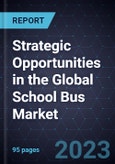A Recovering Demand and Ongoing Electrification Efforts Bolster Growth
This report on the global school bus industry provides an in-depth analysis of the growth environment, global trends, and an extensive examination of the school bus space segmented by region.
The global school bus industry is expected to grow at a 4.1% rate as market demand experiences a rebound after the pandemic, with replacement for aging fleets contributing to growth. In 2022, the total school bus shipments rose to 59,346 units, and the largest share went to North America (combining the United States and Canada), with 40,556 school buses sold in 2022, followed by India with 13,659 buses and China with 5,131 buses.
In the United States, the introduction of the 'Clean School Bus' (CSB) program as part of the Bipartisan Infrastructure Law by the Biden administration aims to replace current fossil fuel buses with low- and zero-emission buses. The benefits of this federal program are paramount to both the environment and the health of school children, as the Environmental Protection Agency (EPA) will introduce the Green House Gases (GHG) phase 3 program with stricter emission norms. These factors will determine the growth of electric school buses in North America, with significant market penetration by 2030. In China, electrification will largely depend on the government, as safety is the main factor it considers in school transportation. Similarly, electric school buses will gain ground in India if the government incentives are structured specifically for this segment.
As an alternative to electric, the natural gas powertrain will gain momentum, although natural gas prices have been affected by the Russo-Ukrainian War in 2022. North America already provides incentives for propane, also known as liquefied natural gas (LNG), and it is included in the CSB program under the low-emission category. In India, compressed natural gas (CNG) school bus offerings see boosting from OEMs as CNG is cost-effective compared to diesel.
Regarding segment classification, in 2022, medium-duty buses led the market with 67.4% out of the total school bus industry, light-duty buses reached 26.2%, while heavy-duty constituted 6.5% of the market. Medium-duty school buses will continue to dominate the market as they offer higher seating capacity with optimal efficiency in operations. The light-duty segment is preferred in urban areas due to its easy maneuverability with moderate operating distance.
With electrification in the anvil, the focus on advanced driver assistance systems (ADAS) is expected to gain prominence as safety norms for school buses in North America are more advanced compared to other markets; and while the telematics market for school buses is poised to grow, there is an expectation for safer school transportation and reducing operation costs through fleet management solutions. The revision of existing school bus safety standards in markets like India and China will likely ensure the introduction of new technology safety systems, which further contribute to the preference for regulated school bus usage over other forms of transport.
Table of Contents
Companies Mentioned (Partial List)
A selection of companies mentioned in this report includes, but is not limited to:
- Ashok Leyland
- Blue Bird Corporation
- Tata Motors
- Thomas Built Buses
- Yutong Bus
- Zhongtong Bus








